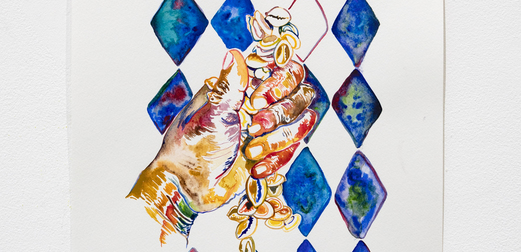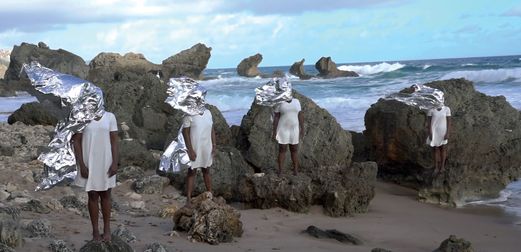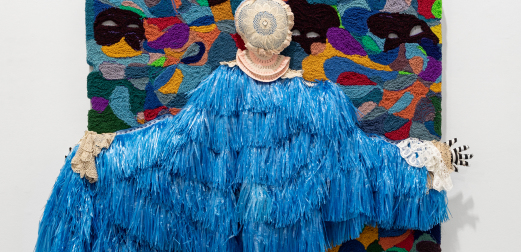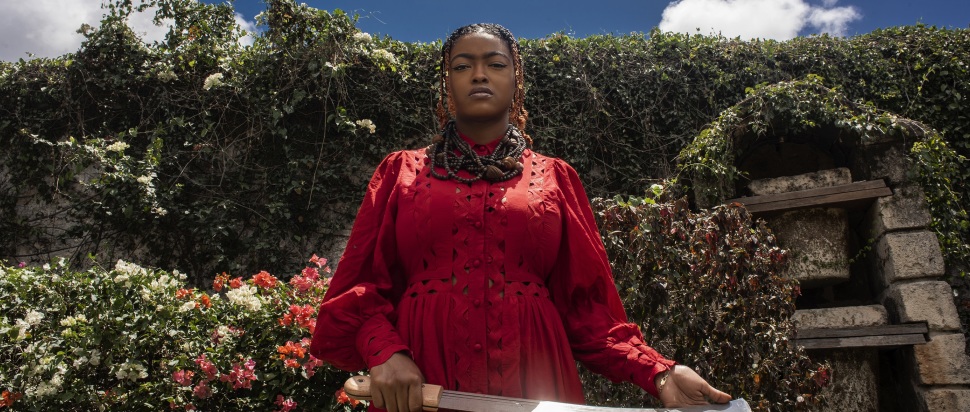Ancestral Meditations: Alberta Whittle interview
Alberta Whittle's create dangerously celebrates a vital and visionary artist whose expansive and generous practice shines a light on some of the most urgent issues of our time
The vast central passageway of Modern One glimmers in a gradient of blues, greens and purples, as if a gentle wave has washed over the space, sparkling and effervescent. In this exhibition, the ocean – the Atlantic specifically – is everywhere. It swirls and ripples through the moving image works; it offers the cowrie shells that the artist uses to adorn many of her collages and sculptures; it bears witness in the artist’s performative and hypnotic digital collages. Invocations of Mami Wata and other ancestral maritime beliefs surface across paintings, collages and films. The ocean also directs the audience to the long and entangled histories of this island that we find ourselves on, and the island of the artist’s birth – Barbados.
In this exhibition, more than ever before, Alberta Whittle invokes the place of her birth – the seawater; the lush, emerald vegetation of the island; the former plantations that haunt its landscape. The exhibition is deeply indebted to Bajan people and history – one of the rooms is a dedication to Kamau Brathwaite, the late Barbadian poet and academic who was a stalwart of cultural studies across the diaspora. Brathwaite’s voice fills the space, which is painted a pensive midnight blue, adorned with a delicate wall painting in white and an array of objects including snake plants and a calabash. It is, at once, a shrine and a sanctuary.
The Arrivants, a poetic trilogy and perhaps his most iconic text, gives its name to a circular painting of a wild forest, embellished with a graceful swath of golden raffia. In another installation, a half-submerged chattel house, the artist laments the death of The Great Carew – also known as Neville Denis Blackman. The revered Bajan calypso singer died tragically in 1995, when his house, on the west coast of the island, was swept out to sea. The installation points to the disproportionate impact of the climate crisis on communities of colour, and how five centuries of colonialism has irreversibly disrupted and altered Caribbean ecologies.

Throwing bones for... Courtesy of Alberta Whittle and The Modern Institute. Photo by Patrick Jameson.
Throughout the exhibition, recurring motifs such as cowrie shells and diamonds point to histories of trade, enslavement and extraction, surfacing in many guises in Whittle’s paintings, sculptures and installations. In Entanglement is more than blood, which was shown as part of the artist’s commission for Scotland + Venice, a large tapestry sprawls across green iron gates, threaded with beads, cowrie shells and hair clips. The ominous sense here of incarceration and confinement is palpable – I am reminded of domestic security contraptions that are pulled across doors, often used in countries like South Africa, where particularly violent colonial histories have morphed into inequality and subsequent fears of violence. The solidity of the steel, however, contrasts beautifully with the fluidity of the tapestry and its delicate embellishments.
A critique of police and state violence, Lagareh – The Last Born forms the focal point of the exhibition, also restaged from Whittle’s representation of Scotland at last year’s Venice Biennale. It is perhaps Whittle’s most explicit and evocative statement on the violence of the British state, with the artist demanding that ‘Premature death at the hands of the government must end’. In another scene, Dr Isatu Smith delivers a haunting monologue about the treatment of enslaved people on Bunce Island in Sierra Leone, touring a graveyard where enslaved Africans were buried without grave markers. Musician Kumba Kuyateh, performing in the Mandinka language, delivers an elegiac praise song in an austere London courtroom in dedication to Sheku Bayoh, who was murdered by the police in Kirkcaldy in 2015.

Holding The Line, A refrain in two parts. Courtesy of the Alberta Whittle and The Modern Institute
The film explicitly connects the violence of the transatlantic slave trade with the murder of Bayoh and the continued violence exercised on Black bodies – and dispels the myth that anti-Black racism and police violence is an American and English problem. The film ends with a list of names of people of colour murdered by the police in the UK. Here, grief is at its rawest, and violence at its most close and cruel. But, as always with Whittle’s moving image works, there are moments of warmth and tenderness – time and space to breathe. In a particularly poignant scene, a queer couple – friends of the artist – discuss the upbringing they wish to provide for their children. This ethos of taking a breath, of finding rest and respite amidst difficult conversations, is one of the most distinctive and magnetic aspects of Whittle’s practice. It takes precedence in the set of visual, oral and textual languages that the artist has spent many years developing.
This conscious and compassionate way of working (which also includes close collaborations with a constellation of artists, musicians, writers who she describes as ‘accomplices’), encourages the audience to collaborate on how to combat the violence of police brutality, anti-Blackness and climate change. The audience becomes both witness and participant in Whittle’s work – and she urges her audience to work towards a solution to these issues. The title of the exhibition itself – borrowed from Haitian-American writer Edwidge Danticat – acts as a further invitation to conspire against the continued violence of colonialism. The phrase beautifully captures the collaborative and community-focused aspects of Whittle’s practice – seen, in just one example, in the hanging textile work produced with members of Project Esperanza, an Edinburgh-based organisation supporting women of African descent.

Taking a leap toward the ancestors (remembering G). Courtesy of Alberta Whittle and The Modern Institute. Photo by Patrick Jameson.
The exhibition is also an opportunity to see how Whittle’s decolonial visions take form in drawings, collages and paintings – many of which are being shown for the first time. In several works, such as Poised and ready to counter the hard-hearted gaze of surveillance, we see the artist producing works that fuse painting and sculpture. The culturally-charged materials – which include Florida Water, rum, and a re-purposed British army jacket – are stitched together with a similiar intuition and sensibility as the moving image works. A series of new circular paintings, many of them set against swirling, hazy backdrops, relate to family stories, mythologies and dreamscapes.
I ask Alberta about her differing processes of making, in regards to the paintings in the exhibition: "Initially I got back into painting during a very intensive working period in my moving image practice so the two forms of making feel very intertwined. Often when I was editing, I needed to work with a different material to allow the moving image work to breathe. Now when I work on my paintings, it’s still about figuring out ideas but there’s often a very visceral feeling of release, especially since most ideas can come from my dreams or from half-forgotten memories."
Perhaps the most striking aspect of the exhibition is the way that the artist makes herself vulnerable. In one of the rooms, visitors can literally walk in her footsteps, which are cast in a series of hypnotic and effervescent resin tiles and placed on the wall and the ground. In Palavar, a wall-based sculptural assemblage, conch shells and cast bronze tongues accompany a cow jaw bone, which the artist collected at the site of a former plantation where her ancestors had laboured.
This proximity to these violent histories of colonialism and slavery – which, in the global north, is so often met with inertia and apathy (something the artist has coined "the luxury of amnesia"), is a fact of life for Black and racialised people living in the Caribbean and across the global south. I ask Alberta about this vulnerability, and why it felt necessary to open herself up to her audience in such a generous way: "The idea of being vulnerable and again taking risks has felt more and more necessary as conditions of making and even surviving have grown increasingly challenging under the hostile environment. I’ve learned so much about staying vulnerable from friends, family, loved ones, my ancestors, my accomplices, and these lessons have often taken the form of storytelling."
With striking vulnerability and an intentional and compassionate approach to making, Whittle has created the possibility for discussing some of the most vital and consequential concerns of our time, while also providing soothing opportunities to pause, rest and reflect. She has undeniably become a powerful advocate for a new generation of artists who want to critically examine the status quo of white supremacy, anti-Blackness and climate catastrophe.
Alberta Whittle, create dangerously, National Galleries Scotland (Modern One), Edinburgh, free, until 7 Jan 2024, part of Edinburgh Art Festival 2023
Whittle will perform a newly-commissioned performance which takes inspiration from her most recent moving image work Lagareh – The Last Born, presented by Edinburgh Art Festival and National Galleries of Scotland on 13 August. Tickets available from the end of June via edinburghartfestival.com
